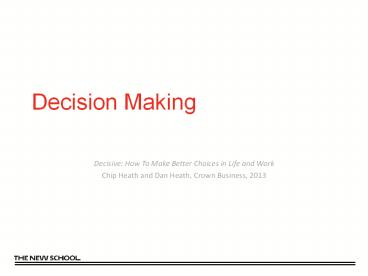Decision Making PowerPoint PPT Presentation
Title: Decision Making
1
Decision Making
- Decisive How To Make Better Choices in Life and
Work - Chip Heath and Dan Heath, Crown Business, 2013
2
The Four Villains ofDecision Making
- Narrow framing
- The tendency to define our choices too narrowly,
to see them in binary terms. - Confirmation bias
- To develop a quick belief about a situation and
then seek out information that bolsters our
belief.
3
- Short-term emotion
- We are governed in decision making by how we feel
about a situation and not necessarily about the
long-term effects of a decision. - Overconfidence
- People think they know more than they do about
how the future will unfold. - Punditry is the perfect example.
4
Making Good Decisions
- Widen your options (overcome narrow framing)
- How can you expand your set of choices?
- Rather than either/or binary options, uncover
new options and think this and that. - Reality-test your assumptions (overcome
confirmation bias) - How can you get outside your head and collect
information that you can trust?
5
- Attain distance before deciding (overcome
short-term emotion) - Wait a couple of dayssleep on it. Use Ben
Franklins method of making a long pros-and- cons
list over several days, and then analyzing it
objectively. - Prepare to be wrong (overcome overconfidence)
- Plan for an uncertain future have a Plan B and
Plan C.
6
W.R.A.P.
- Widen your options.
- Reality-test your assumptions.
- Attain distance before deciding.
- Prepare to be wrong.
7
Effective Decision Making
- Based on the book Smart Choices A Practical
Guide to Making Better Decisions, John S.
Hammond, Ralph L. Keeney, Howard Raiffa, Harvard
Business School Press, 1999.
8
The Eight Elements of Effective Decisions
- Problem
- Objectives
- Alternatives
- Consequences
- Tradeoffs
- Uncertainty
- Risk Tolerance
- Linked Decisions
9
- Problem
- Be creative about your problem definition
- Turn problems into opportunities
- Reexamine your problem definition as you go
- Maintain your perspective
10
- Objectives
- Let your objectives be your guide
- Objectives determine what information you seek.
- Objectives can help you explain your choices to
others. - Master the art of identifying objectives
11
- Alternatives
- Dont box yourself in with limited alternatives
- Use your objectives and ask how?
- Set high aspirations
- Ask others for suggestions
- Give your subconscious time to operate
- Incubate
- Never stop looking for alternatives
- Think outside the box, brainstorm
12
- Consequences
- Compare alternatives using a consequences matrix
- Use experts to help define consequences
13
- Tradeoffs
- Use swaps
- Determining the relative value of different
consequences is the hard part
14
- Uncertainty
- Use risk profiles to simplify decisions involving
uncertainty - What are the key uncertainties?
- What are the possible outcomes of these
uncertainties? - What are the chances of occurrence of each
possible outcome? - What are the consequences of each outcome?
- Use experts to help define possible outcomes
15
- Uncertainty
- Use a Decision Tree
- Alternatives - Uncertainty - Consequences
16
Decision Tree
B Go
A Go
B No Go
A
B Go
A No Go
B No Go
17
- Risk Tolerance
- Understand and calibrate your groups tolerance
to take risks - Incorporate your risk tolerance into all of your
decisions
18
- Linked Decisions
- Linked decisions are complex
- Ask How will this decision affect other people,
other departments, other divisions, partners,
your industry?
19
Decision Making Summary
- Problem
- Objectives
- Alternatives
- Consequences
- Tradeoffs
- Uncertainty
- Risk Tolerance
- Linked Decisions
20
Seven Basic Rules
- Make bold decisions that challenge the status quo
- Avoid choices that justify past bad decisions
- Check for faulty cause-and-effect reasoning
- Test your decisions with experiments (shoot
bullets, not cannonballs) - Root out unconscious prejudices
- Foster and address constructive criticism
- Defeat indecisiveness with clear accountability

